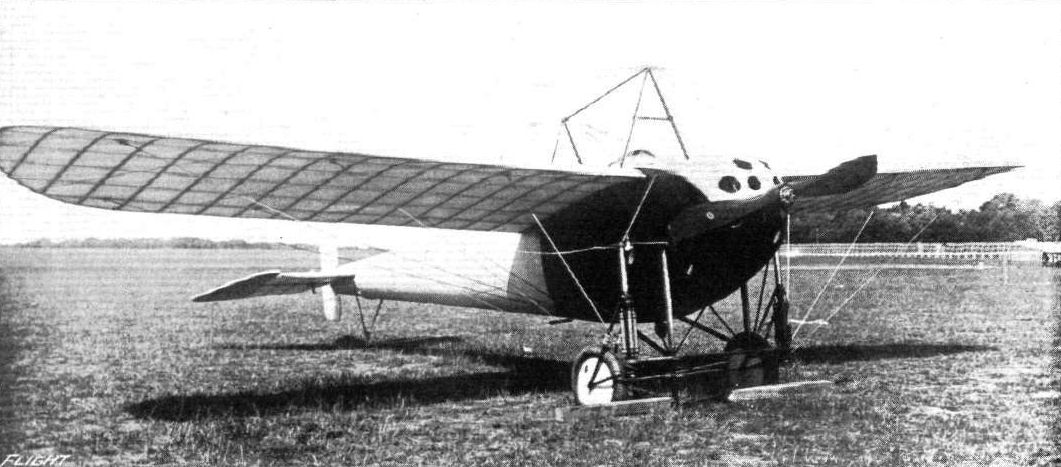L.Opdyke French Aeroplanes Before the Great War (Schiffer)
Deleted by request of (c)Schiffer Publishing
In 1913 several other aeroplanes were designed - some were even built - whose designations have been lost. One of them was probably the big side-by-side 3-fIoat seaplane flown by Perreyon; it resembled a float version of the XXI, and was photographed in November 1913. Another was a very modern-looking midwing monoplane designed to shoot down dirigibles: it had a 37 mm cannon firing through the center of the propeller hub.
In July 1914 still another Bleriot armored monocoque monoplane appeared. There may have been only the one; its factory designation is unknown. It had the words La Vache (the cow) painted on the side. A small rudder hung at the aft point of the fuselage, preceded by a tail surface with horn-balanced elevators. It was powered by a 160 hp Gnome.
Журнал Flight
Flight, February 26, 1915.
THE 160 H.P. ARMOURED BLERIOT TWO-SEATER.
JUST before war was declared, M. Bleriot had started experiments with a new type of armoured monoplane, fitted with a 160 h.p. motor, and although the tests had to be abandoned, the two machines of the type which had been constructed were pressed into service, and both of them # one in the hands of Vedrines # have rendered a good account of themselves at the Front.
As will be seen from the photographs which we reproduce, with the exception of the body and allowing for the difference in size and power, there is comparatively little departure from what may be termed standard Bleriot practice, the wings, which have rather a pronounced dihedral, being identical in general construction and shape to those fitted to the ordinary type of machine. Lateral control is, as usual, effected by the warp of the wings, the warp wires being carried to the bottom pylon, which is enclosed within the body. The top load wires, it will be seen, are attached to the forward end of a double mast of somewhat similar design to that fitted to the "total visibility" type machine, which is mounted upon the body; while the top warp wires are carried up to the rear end of this structure.
The body is of the #coque" type, and is of ample depth, so as to allow the gunner to use his gun either when standing inside the machine or when seated, and to permit of access to the holes at the side of the armoured casing. This casing extends from the extreme forward end of the body to the rear of the gunner's seat, and is made of 3 mm. chrome nickel steel, thus completely enclosing the engine # a 160 h.p. Gnome # the pilot, gunner, all tanks and the controls, and affording the maximum amount of protection against the effects of small gun and rifle fire; while the underneath portion of the body is well rounded, so as to minimise the penetrating power of a projectile, which strikes the armour at an angle. Suitably positioned holes are cut in the nose of the machine to allow of the entrance of sufficient air to cool the engine; and doors are provided, one on each side, beneath the wings and near the front (see the three-quarter front view), through which the gunner can fire at an object beneath the machine. The remainder of the framework of the body is embedded within a papier-mache casing, over which canvas is sewn, with the object of minimising the risk of failure of a machine in the air in the event of the framework being struck by a bullet; as it has been proved by experiment that the wood does not so readily splinter when enclosed in this fashion, as when exposed with no support.
The tail and the undercarriage call for little comment, as they so closely follow the usual Bleriot practice. The tail skid is similar to that on the Bleriot monocoque which was exhibited; at the last Paris Show, being attached by wires and shock absorbers to the body and to the tail.
During tests conducted in France the machine was loaded up with a weight of 165 lbs. to compensate for the absence of armanent and projectiles, and the weight of the pilot, passenger and accessories amounted to 375 lbs., while sufficient fuel and oil was carried to enable a three hours' flight to be made. Under these conditions of loading it was required to attain a speed of 130 kiloms. per hour (81 miles per hour) in straight flight, be capable of climbing at the rate of 1,000 metres in ten minutes (328 ft. per min.), and land within a field of not more than 100 metres (109 yards in length). It speaks well for the design of the machine that despite the heavy load carried it was easily able to satisfy these requirements.




